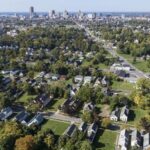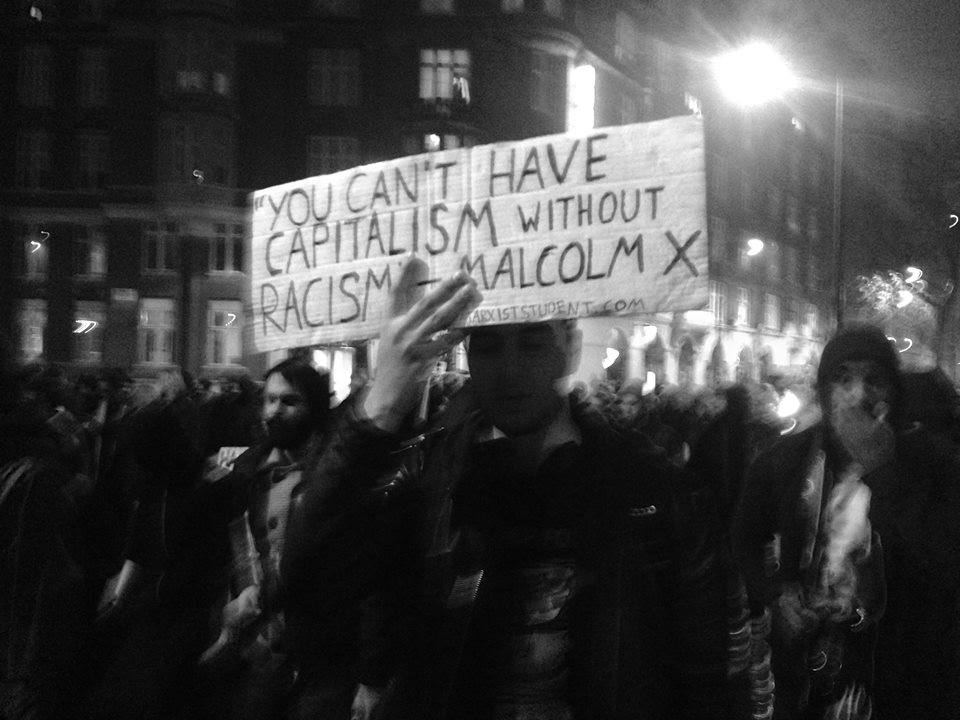Land Valuation and the Enduring Significance of Racial Residential Segregation
A Flint, Michigan Presentation
June 30, 2021
Department of Urban and Regional Studies
Center for Urban Studies
Community Health Equity Research Institute
University at Buffalo
Henry-Louis Taylor, Jr.
This evening my presentation focuses on the enduring significance of racial residential segregation and its relationship to the underdevelopment of Black communities. It consists of two parts. The first part examines the interaction among land valuation, racial residential segregation, and the underdevelopment of Black neighborhoods. The second part focuses on intervention and strategies for developing Black communities while simultaneously dismantling racial residential segregation.
The life chances of many African Americans are tied to their experiences in underdeveloped urban neighborhoods. The implication of living in these Black spaces is reflected in the provocative question posed by the historian Carol Anderson in her book, Eyes Off the Prize, which I paraphrase. How could the Civil Rights Movement leave in its wake a nation where schools are more segregated than ever, where Black workers are stuck in low-income jobs, where racial residential segregation is a dream deferred, where most Black children live in poverty, where significant health disparities exist between the races, and where Blacks comprise 32% of American prisoners but only 13% of the population?
I theorize that African Americans have made minimal socioeconomic advancements since the Civil Rights era because of racial residential segregation. I want to stress that residential segregation is more than merely separating Blacks and Whites in geographic space. It is a market-driven process that denies Blacks equitable access to education, jobs, income, health care, and other critical services that bolster their possibilities for socioeconomic advancement. Thus, neighborhood-based barriers to Black advancement mean that African Americans cannot make significant progress without developing their communities while simultaneously dismantling racial residential segregation.
The Residential Segregation Project
Why is this the case? Racial residential segregation is the linchpin of Black inequity. It drives the concentration of Blacks in marginalized, underdeveloped neighborhoods that turn Blacks into workers willing to accept low-paying, dead-end jobs with few benefits and no job security. Then, the big question is why racial residential segregation endures, as if immutable and fixed in time and space. Despite the passage of the Fair Housing and the Housing and Urban Development Acts of 1968 and the outlawing of redlining, restrictive covenants, and discrimination in the rent and sale of housing, racial residential segregation persists and continues to frame storylines about Blackness and Whiteness in American society. I argue that racial residential segregation endures because the real estate industry, White homeowners, and the government are the beneficiaries.
Let me explain. A racist land valuation system undergirds and produces residential segregation. The real estate appraiser Frederick M. Babcock developed the system during the depression era. Back then, the government aimed to use mass homeownership as an economic development tool to reboot the economy. Before World War II, home buying was a risky business that required the homebuyer to put 50% down on the house and repay the loan within two to five years. Mortgage renewal was possible, but it was not guaranteed. Therefore, to create a mass homeownership system, the government needed to develop an amortize mortgage that extended the loan over 20 years. However, for such a mortgage system to work, real estate appraisers required a method of evaluating residential land to guide the investment decisions of mortgage brokers.
Babcock, who became the chief underwriter for the Homeowners Loan Corporation in 1936, used the alchemy of race, place, economics, and culture to forge such a land valuation system. He detailed this theory in his 1932 textbook, the Real Estate Valuation. Babcock played to the racist sentiments of Whites in developing this system. He theorized that neighborhoods had life cycles and that the presence of Blacks signaled the onset of decline in White communities. Black residents, then, threatened White neighborhood stability, thereby increasing risk and lowering property values. Thus, Babcock’s land valuation system interlocked racism and residential development. Significantly, the establishment of this land value system was a milestone event, which shaped the mass homeownership movement and drove the neighborhood development process after World War II.
Almost 90 years after Babcock developed his land valuation system, it still drives the American neighborhood and residential development process. In this system, as the percentage of Whites and social class exclusivity increases, so do the house values and the wealth-producing capacity of those residential areas. In contrast, as the percentage of Blacks and social class inclusivity increases, the residential area’s house value, and wealth-producing capacity decline. I use the median household income and the percent of the population with a college degree as determinants of social class exclusivity.
Lastly, housing value becomes the residential node around which neighborhoods are formed and developed in this land valuation system. Therefore, residential districts are scattered across a land value continuum, where communities are clustered around similar valued houses, amenities, hedonic features, and access to quality goods and services. This market-driven residential development process produces a hierarchy with developed, high-valued White neighborhoods at one pole and underdeveloped, low-value Black neighborhoods at the opposite end. Thus, the land valuation system is the force that drives racial residential segregation in the United States. Moreover, in this system, the value of White homes is based on the devaluation of Black homes. In the United States, you cannot have developed White neighborhoods without simultaneously having underdeveloped Black communities. Therefore, Whites embrace racial residential segregation because they benefit from it. This interactive relationship between Black and White communities is the hard reality that we must confront to develop a better, more just, and equitable society.
The Land Valuation System in Action
I want to use Erie County, NY, to illustrate how the land valuation system produces racial residential segregation. I rank-ordered Erie County’s twenty-eight municipalities by median house value and grouped them into quartiles to explore the role of housing values in shaping the County’s residential structure. I then grouped the municipalities into quartiles to gain a more in-depth understanding of how Whiteness and social class exclusivity influences house value and the stratification of residential districts. I used the following variables to interrogate the social class dynamics operative in each municipality and quartile: percent White, median household income, percent Bachelor’s degree, percent Black, and percent poverty.
In Erie County, the interplay between Whiteness and social class exclusivity produced a neighborhood hierarchy based on race, class, and housing values. For example, in residential quadrant four, which has the highest median house value in the County, less than 4% of the residents are Black. At the opposite end of the spectrum, in residential quad one, which has the County’s lowest house value, 30% of the residents are Black. To put this issue in a sharper perspective, Clarence has the highest median house value in Erie County. The population is 92% White and 1% percent, Black. At the opposite end, in Buffalo City, which has the County’s lowest median house values, Whites comprise 46% of the population and Blacks 37% of the population.
Erie County is a hyper-segregated community. About 84% of the County’s White population lives in 27 suburban municipalities. On the flip side, 79% of Erie County Blacks live in the city. About 21% of African Americans reside in the suburbs, but over half of them cluster in the inner suburbs, where the lowest house value in Erie County is found. Thus, when most Blacks suburbanize, they move into the low-valued inner suburbs rather than the outer suburbs, where the highest valued homes are found.
Now back to the City of Buffalo. Here, racial residential segregation also prevails. Although only 16% of Erie County Whites live in the city, it is still hyper-segregated. It is a tale of two cities in the same municipality. In Buffalo, Main Street functions as a socioeconomic divide that racially separates the city, and housing values drive the residential segregation process. For example, Whites cluster mainly on the West Side, where the city’s highest housing values are found. Blacks cluster on the East Side, where we find the lowest house values in the city and entire metropolitan region.
These activities notwithstanding, Buffalo and Erie County are not unique. Our preliminary investigations find similar patterns of residential segregation in Cincinnati, Pittsburg, and Philadelphia. In each large metropolitan area, housing values are the driving force behind residential development and racial residential segregation. Even in smaller metros, such as Genesee County and Flint City, housing values still drive residential development and racial residential segregation.
What does all of this mean? These findings tell us that residential segregation is not merely a product of prejudice. It is a system of structural racism based on the interlocking of racism, house values, and residential development. Moreover, it is the system that spawned the new Black inequality in the post-World War II era.
Residential Segregation and Predatory Neighborhood Actions
There is more to this story. Racial residential segregation does more than separate Blacks and Whites in geographic space. It is a multi-dimensional process that impacts the African American community in three interrelated ways. First, it constructs a high wall of rent and housing costs that traps Blacks in underdeveloped neighborhoods. African Americans are stuck in place. Of course, Blacks do move, but they move in context. Their new neighborhoods are similar to the ones they left behind. These underdeveloped neighborhoods, in turn, become crucial sites where race-based inequities are generated, reinforced, and reproduced. In other words, underdeveloped neighborhoods are places that produce and reproduce racial injustice in the United States.
Second, underdeveloped neighborhoods also become the site of segrenomics and predatory actions because of residents’ limited housing and shopping options. The social theorist Noliwe Rooks coined this term to describe the type of profiteering that occurs in segregated communities where choices are limited. For example, the lack of housing options leads to rent gouging in underdeveloped districts. In these communities, predatory landlords generate hyper-profits by delaying or postponing housing maintenance while simultaneously charging high rents. Consequently, most Black renters pay from thirty to fifty percent of their income on housing, leaving little to purchase other necessities, including food, medicine, clothes, and household essentials.
In Flint, for example, in most census tracts, where 70% or more of the population is Black, renters typically pay thirty percent or more of their income on housing. These Blacks are living in homes that are not affordable. To put this high rent in perspective, after a few years in these neighborhoods, the cumulative amount of rent paid will often exceed the value of the rental unit. For example, the median value of owner-occupied houses in Flint’s census tract one is $31,000, while the median gross rent in that tract is $721 or about $9,000 annually. Over five years, the tenant’s cumulative rent will be around $43,000, or about $12,000 more than the value of an owner-occupied house in that same neighborhood.The situation in census tract #1 is not unique. The hard reality is that the housing market calculus will always push housing quality downward while pushing rents upward in underdeveloped Black communities.
The financial situation of residents in these communities is worsened by merchants overcharging for goods and services and financial institutions that bilk them with excessive fees, subprime mortgages, and foreclosures. Simultaneously, local government often does not maintain the streets, sidewalks, and public-owned vacant lots and does not enforce existing housing laws and building codes.
Third, racial residential segregation creates exclusive neighborhoods that give Whites a competitive edge by providing them with access to better-resourced schools, services, and social institutions. Moreover, racial residential segregation fuels individual racism and hatred toward people of color. This isolation from Blacks in everyday life and culture is problematic. It means that White’s knowledge of Blacks comes mainly from what they see on television and in the movies; What they read in the newspaper, what they hear on the radio, and their conversations with friends, family, and acquaintances. Consequently, many Whites unwittingly harbor stereotypic views and false impressions about Black people. The problem is that many of these same Whites end up in positions of power where they develop, implement, and enforce policies that affect the lives of African Americans.
What is to be done? Disrupting Market Forces and Predatory Actions
So, where do we go from here? The life chances of African Americans are tied to their experiences in segregated and underdeveloped neighborhoods. The conditions in these communities will not magically disappear or get better. Progress is neither automatic nor inevitable. It will happen only if you marry a deep understanding of the problem to the correct intervention strategy. The bottom line is that the traditional approaches to developing Black neighborhoods do not work. If it did, racial residential segregation would not exist, most Black children would not be living in poverty, and significant health disparities would not exist between the races. So, we have to design a new approach to developing Black neighborhoods to change this situation.
Such a progressive approach to neighborhood development must disrupt market forces and predatory neighborhood actions. Market dynamics problematizes our quest to bring about neighborhood change. The market is the engine that drives racial residential segregation and disrupts neighborhood life and culture. It does this by placing profits over people, engaging in predatory actions that generate unnecessary hardships, and chronically flipping low-value residential lands to more profitable uses. Consequently, to change this reality, I call for a mixed economic approachto neighborhood development. This strategy uses a combination of non-market and market approaches to development.
Moreover, a progressive approach to neighborhood development must conceptualize the segregated, underdeveloped neighborhood problem as part of the more significant problem of racial residential segregation and neighborhood inequality. Neighborhood development will always be partial unless Blacks, and other low-income people of color, are given full access to the entire metropolitan housing market. Operating within this framework, I theorize that we must use a two-dimensional strategy to develop underdeveloped neighborhoods and eliminate racial residential segregation. In one dimension, we must reimagine and transform the Black community into a great place to live, work, play, and raise a family. Simultaneously, we must dismantle racial residential segregation and the land valuation system undergirding it in the other dimension.
Finally, I want to stress that the neighborhood development strategy, which I will outline momentarily, is based on a set of principles that must be creatively applied to different situations. There is no one-size-fits-all strategy. Neighborhoods are different, even those in the same city. Therefore, the following neighborhood development principles are guidelines to action rather than a blueprint.
Reimagining and Developing the Black Community
So, how do we reimagine and develop the Black community? The first principle stresses the importance of liberating our minds. At this level, we must acquire the capacity to see the invisible, thereby imagining a very different but possible Black community. Such a Black community would consist of inclusive, cross-class neighborhoods characterized by affordable, high-quality housing and accessibility to a wide range of institutions that promote social well-being and human development. Anchoring these neighborhoods would be a system of community control, participatory democracy, collective ownership, and the shared values of reciprocity, collectivism, solidarity, and social justice. In these residential districts, Black folks will have an authentic chance of living healthy lives and becoming the best they can be.
The second principle is that building this type of community requires conceptualizing the “neighborhood” as a social organization, where residents will work as a team to transform their community. The development challenges are significant. Therefore, neighborhood residents must be highly organized and supportive of the community’s vision to achieve these complex and challenging neighborhood development goals. The aim is not just “community involvement” but the building of community leadership and participation in the quest to radically change the residential district.
This approach centers on the neighborhood visioning process—those sessions where residents conjure up their dream of the type of community they aim to build. An old African saying is that a person without a target cannot miss, and neither can they hit anything. The visioning process gives the community a target. Therefore, to be successful, the visioning process must involve all residents, including the most marginalized people in the neighborhood—even the gangsters. And most important, it also essential to hold pre-vision education sessions to prepare residents for their participation in the actual visioning process.
The third principle emphasizes community land trusts as a tool for controlling neighborhood development and spawning participatory democracy, collective ownership, and the building of community wealth. Black people do not own or control the land, housing, and institutions operating in their community. Consequently, their neighborhood’s destiny is always in the hands of outsiders who view the community through the lens of exchange value, where the intent is to make profits and not build vibrant neighborhoods. My point is that the secret to building stable Black communities is to acquire community control and create a source of wealth for neighborhood reinvestment.
Toward this end, the community land trust is the most vital tool in the quest for community control, collective ownership, wealth building, and participatory democracy. The CLT is a non-profit organization administered by residents, aiming to mitigate market forces’ impact on the neighborhood by acquiring ownership and control over community land and housing. The CLT engages in various projects that are beneficial to the community, including high-quality housing for low-income residents. On this point, the key to a viable housing strategy is to eliminate the rent cost burden by lowering costs while simultaneously increasing housing quality. The fact is that low-income tenants should never pay more than 20% of their income on housing. Such a rent reduction would increase their purchasing power and bolster the quality and longevity of their lives.
At the same time, I also want to stress that community land trusts are about more than affordable housing. They are also about building community wealth. The land trust can also acquire commercial properties and engage in economic development activities beneficial to the community.
The fourth neighborhood development principle involves community economic development. Here, the intent is to abolish segrenomics, predatory actions and gain control over the neighborhood economy by forging strategies to maximize the capture rate of dollars flowing into the community and reinvest surplus dollars in varied community development projects. There are multiple ways to achieve this goal, including establishing neighborhood development districts, business improvement districts, and developing cooperatives and worker-owned businesses.
The fifth and last principle of neighborhood development is to create a connection between economic and community development. The aim is to establish training programs that will prepare residents to participate in all phases of neighborhood development. In addition to training workers, there is also a need to develop entrepreneurial support programs to maximize Black business involvement in the neighborhood development process. The intent is to maximize the participation of all residents in the recreation and development of their residential district. The aim is to make it possible for people to rebuild their lives as they rebuild their communities.
Disrupting Racial Residential Segregation
The saga does not end here. The tethering of land values to racial residential segregation situates the struggle for housing and neighborhoods in a metropolitan context and places the battle to unlock the suburbs at its core. Blacks cannot solve their housing and neighborhood problems without creating access to the entire metro housing market. American apartheid is not just a central city phenomenon. Therefore, we must attack it simultaneously in the central city and the surrounding suburbs. The aim is to aggressively enforce fair housing laws while simultaneously supporting residential mobility strategies and calling for the building of low-income renter and owner-occupied housing units in the suburbs.
These residential mobility strategies are not merely about “racial healing” and living next door to White folks or becoming their buddies. In contrast, it is about transforming these White-dominated neighborhoods into communities that can accommodate and meet the needs of Black folks and other people of color. Therefore, the dismantling of residential segregation is about the transformation of White neighborhoods into multi-racial, cross-class communities. Such changes require eliminating the culture of White supremacy, mitigating the harmful effects of market dynamics, and reimagining White suburban and central city space. Of course, for this to happen, Whites must be intimately involved in this re-engineering project and actively embrace the concept of building a multi-racial, cross-class anti-racist society.
In closing, the abundant neighborhood effects literature indicates that Blacks will never get free if they live in stigmatized, marginalized, and underdeveloped neighborhoods, plagued by predatory actions and complicit government officials. Yet, progress is neither automatic nor inevitable. Therefore, to bring about social change, we must adopt bold new strategies to develop underdeveloped neighborhoods and dismantle racial residential segregation.
Author Profile
Latest entries
 Selected Media05/04/2024The Occupation of Hayes Hall: Student Rebellions and Remaking the U.S. UniversityThe Occupation of Hayes Hall
Selected Media05/04/2024The Occupation of Hayes Hall: Student Rebellions and Remaking the U.S. UniversityThe Occupation of Hayes Hall Selected Media03/21/2024Ryan’s infill housing strategy is the right plan for Buffalo
Selected Media03/21/2024Ryan’s infill housing strategy is the right plan for Buffalo Selected Media03/01/2024How We Change the Black East Side: From “The Harder We Run” to “Black Neighborhoods Matter”.
Selected Media03/01/2024How We Change the Black East Side: From “The Harder We Run” to “Black Neighborhoods Matter”. Selected Media05/02/2023Tension between the U.S. and China is growing.
Selected Media05/02/2023Tension between the U.S. and China is growing.



